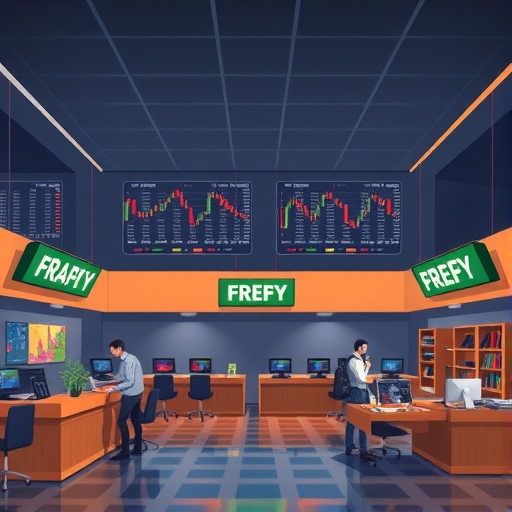Navigating the U.S. Treasury Futures Market: A Comprehensive Investor’s Guide
Do you ever wonder how large financial institutions manage their exposure to interest rate changes, or how they bet on the future direction of the economy? Investing in financial derivatives, particularly Treasury futures, can seem complex, yet these instruments offer powerful tools for managing risk and capitalizing on market dynamics in U.S. government debt. This article serves as your essential guide, demystifying Treasury futures from their core definitions and contract specifics to advanced trading strategies, robust risk management techniques, and the underlying mathematical frameworks. We will also explore recent innovations like Weekly Treasury Options and SOFR/T-Bill spreads, equipping you with the critical knowledge to confidently navigate this dynamic segment of the financial market and enhance your broader investment strategy.
The Foundation: Understanding Treasury Futures and Bond Market Interplay
At its heart, a Treasury future is a contractual agreement to buy or sell U.S. government debt instruments—like bonds, notes, or bills—at a predetermined price on a future date. Think of it as a promise, locked in today, for a transaction that will happen later. The primary purpose of these contracts is twofold: first, for hedging against interest rate risks, protecting existing portfolios from unexpected market moves; and second, for speculating on the future direction of interest rates. We often see these traded on regulated exchanges like the Chicago Board of Trade (CBOT), which is part of the CME Group. 
What makes these contracts so useful? They are highly standardized, meaning every contract for a specific Treasury product has the same maturity, value, and minimum price fluctuation, known as a “tick size.” For instance, a 10-year U.S. Treasury Note future represents $100,000 face value of the underlying note. Its tick size is typically 1/32nd of a point, equivalent to approximately $31.25 per contract. This standardization, coupled with high liquidity, makes them incredibly efficient. They also involve margin requirements, which means you only need to put up a small percentage of the contract’s total value to control a much larger amount of debt. This leverage can amplify both gains and losses.
Understanding the different types of U.S. Treasury instruments is essential for comprehending the underlying assets of these futures contracts. Each type serves a distinct purpose in government finance and offers varying maturities.
| Instrument Type | Typical Maturity | Key Characteristic |
|---|---|---|
| Treasury Bills (T-Bills) | Up to 1 year | Issued at a discount, no coupon payments. |
| Treasury Notes (T-Notes) | 2 to 10 years | Pay fixed interest (coupon) every six months. |
| Treasury Bonds (T-Bonds) | 10 to 30 years | Pay fixed interest (coupon) every six months, longest maturity. |
To truly understand Treasury futures, we must grasp the fundamental principles of the bond market. The most crucial concept is the inverse correlation between interest rates and bond prices. When interest rates rise, newly issued bonds offer higher yields, making existing bonds with lower yields less attractive. This causes the prices of older bonds to fall. Conversely, when interest rates fall, existing bonds with their higher, locked-in yields become more valuable, and their prices rise. This relationship is the bedrock of how Treasury futures move.
To summarize, key principles of bond market interplay include:
- Bond prices and interest rates move in opposite directions; when one rises, the other falls.
- Treasury futures offer significant leverage, amplifying potential gains and losses.
- Standardization and liquidity are core advantages of Treasury futures.
Several factors influence this delicate balance. On the supply side, the U.S. government issues massive amounts of Treasury securities to finance its spending, which affects how many bonds are available. On the demand side, global investors seek the safety and stability of U.S. government debt, influencing its pricing. Moreover, macroeconomic indicators are paramount. Data like inflation, GDP growth, and employment data directly impact market sentiment and the outlook for interest rates. Most critically, decisions made by the Federal Reserve—the U.S. central bank—on monetary policy have a profound and immediate effect on interest rates and, by extension, Treasury futures prices. Understanding these dynamics is the first step to navigating this market.
Trading Mechanics, Strategies, and Essential Risk Management
Once you understand the basics, the next step is to explore how Treasury futures are actually traded and the strategies you can employ. Trading primarily occurs on regulated exchanges such as the Chicago Board of Trade (CBOT).  When you decide to trade, you can take one of two main positions: going long, meaning you expect interest rates to fall (and bond prices to rise), or going short, anticipating that interest rates will rise (and bond prices will fall). Remember, as we discussed, bond prices and interest rates move inversely.
When you decide to trade, you can take one of two main positions: going long, meaning you expect interest rates to fall (and bond prices to rise), or going short, anticipating that interest rates will rise (and bond prices will fall). Remember, as we discussed, bond prices and interest rates move inversely.
Operationally, trading futures involves two key aspects: margin requirements and daily mark-to-market adjustments. Margin is the collateral you must deposit to open and maintain a position. Because futures are highly leveraged instruments, a relatively small margin can control a large contract value. Daily mark-to-market means that your account is adjusted at the end of each trading day to reflect your gains or losses, ensuring that all participants maintain sufficient margin to cover potential losses. 
To illustrate the core trading positions, consider the following table which outlines the expectations and outcomes for long and short futures positions.
| Position Type | Interest Rate Expectation | Bond Price Expectation | Outcome (Profit/Loss) |
|---|---|---|---|
| Long Futures | Expects rates to fall | Expects prices to rise | Profits if bond prices rise, loses if prices fall. |
| Short Futures | Expects rates to rise | Expects prices to fall | Profits if bond prices fall, loses if prices rise. |
Here are some of the most common trading strategies using Treasury futures:
- Hedging: This is perhaps the most fundamental use. If you own a portfolio of bonds and fear rising interest rates will decrease their value, you can sell (go short) Treasury futures. If rates do rise, the loss on your physical bonds will be offset by the gain on your futures position, effectively minimizing your portfolio risk.
- Speculation: Traders who believe they can predict short-term market fluctuations use futures to profit from anticipated price movements. For example, if you expect the Federal Reserve to cut rates, you might go long on futures, betting on rising bond prices.
- Spread Trading: This involves simultaneously taking positions in two related futures contracts to profit from the difference in their prices. This could be buying a near-month contract and selling a far-month contract (inter-delivery spread) or even trading different Treasury products against each other (inter-market spread). The goal is to profit from changes in the price relationship, rather than outright price direction.
- Arbitrage: More advanced traders might exploit tiny price discrepancies between the cash bond market and the futures market. This involves buying the cheaper asset and selling the more expensive one, locking in a small, risk-free profit.
Regardless of your strategy, effective risk management is crucial. The inherent leverage risk in futures means that small price movements can lead to significant gains or losses. Therefore, consider these essential tactics:
- Implementing Stop-Loss Orders: Automatically closing your position if it reaches a predetermined loss level.
- Diversifying Portfolios: Not putting all your eggs in one basket, even within the bond market.
- Adjusting Position Sizing: Only allocating a portion of your capital to any single trade, commensurate with your risk tolerance.
- Conducting Stress Tests: Imagining worst-case scenarios and how your portfolio would fare.
- Regularly Monitoring Economic Data: Staying informed about macroeconomic indicators that can cause sudden market volatility.
Beyond leverage, be aware of liquidity risk, which can arise in extreme market conditions where it becomes difficult to exit a position without impacting its price. By combining sound strategies with rigorous risk management, you can navigate the dynamic world of Treasury futures with greater confidence.
The Ingenuity of Delivery: Basket Design and CTD Dynamics
One of the less obvious, yet highly ingenious, aspects of Treasury futures is their unique delivery basket design. Unlike some futures contracts that specify delivery of a single, exact underlying asset, Treasury futures allow for the delivery of any U.S. Treasury security that falls within a predefined “basket” of eligible bonds or notes. For example, the 10-year U.S. Treasury Note future doesn’t specify one particular 10-year note; instead, it allows for delivery of several different 10-year notes that meet specific maturity and coupon criteria. This design is a key success factor because it aggregates liquidity across multiple cash Treasury securities, which might otherwise be thinly traded individually. This flexibility facilitates the contract’s growth and makes it a more efficient tool for risk management.
Central to this basket design is the concept of the Cheapest-to-Deliver (CTD) security. From the eligible securities in the delivery basket, the CTD is the U.S. Treasury bond or note that a seller of a futures contract can deliver at the lowest cost. In essence, it’s the most economically advantageous bond for the short (seller) to deliver. The price of the futures contract is largely derived from the price of this CTD security, adjusted by a “conversion factor” and accrued interest. The conversion factor is a specific multiplier that standardizes the price of different deliverable bonds to the standardized futures contract. Understanding the CTD is crucial because it significantly influences the futures pricing.
While the CTD usually remains stable for a given contract, sometimes “CTD switches” can occur. These are rare but possible changes in which security becomes the cheapest to deliver. They typically happen due to significant shifts in the yield curve – the relationship between bond yields and their maturities. When a CTD switch occurs, it can impact the effective duration of the futures contract, which measures its price sensitivity to interest rate changes. For traders and portfolio managers, a CTD switch might necessitate a rebalancing of their portfolios to maintain their desired risk exposure. This dynamic interplay between the delivery basket, the CTD, and the yield curve highlights the sophistication inherent in the Treasury futures market and the continuous need for participants to monitor market conditions.
Expanding Horizons: Weekly Treasury Options and SOFR/T-Bill Spreads
The Treasury futures market is constantly evolving, with recent innovations providing even greater precision and flexibility for traders and hedgers. Two notable advancements are the expansion of Weekly Treasury Options (WTOs) and the introduction of Three-Month SOFR / 13-Week T-Bill (SR3/TBF3) Spreads.
Weekly Treasury Options (WTOs) on Treasury futures have significantly expanded the opportunities for traders to position for or hedge against event-driven volatility. The recent listing of Tuesday and Thursday WTOs on CME Group platforms, complementing the existing Monday, Wednesday, and Friday expirations, means there are now daily options opportunities throughout the week. This allows for incredibly precise positioning around specific economic reports or Treasury auctions. For example, if you anticipate a strong reaction to the Employment Situation report, or the Consumer Price Index (CPI), or Retail Sales data, you can use a WTO expiring shortly after that report to take a targeted view. Similarly, they are useful for positioning around major Treasury auctions, like the 2-year or 30-year bond auctions.
These options have seen significant growth, with average daily volume and open interest rising year-over-year, reflecting their increasing adoption by market participants. WTOs have specific naming conventions (e.g., symbol + week + month + year) and listing intervals. They also physically exercise into the underlying Treasury futures contract. It’s important to note the differences in expiration rules: Monday-Thursday WTOs are typically auto-exercised or abandoned, while Friday WTOs allow for contrary instructions, offering more flexibility for traders right up to 4 PM CT on expiry day.
Another strategic innovation is the Three-Month SOFR / 13-Week T-Bill (SR3/TBF3) Spread. This product, tradable on CME Globex, is a predefined 1:1 spread ratio linking SOFR futures (SR3) and 13-Week T-Bill futures (TBF3). Both SR3 and TBF3 contracts have identical contract months and largely overlapping interest rate exposure intervals, making them a natural pair for spread trading. The key difference to manage is that SR3 contracts remain tradable longer than TBF3 after the TBF3 expiry, requiring active management for spread positions.
What’s the strategic advantage of the SR3/TBF3 spread? It offers a more refined portfolio hedge for mitigating asset swap risk in cash T-bill portfolios that are typically hedged with SOFR futures. While SOFR futures are an excellent general hedge for short-term rates, T-bill yields and SOFR rates can respond differently to various market conditions, creating basis risk. This spread provides a more precise hedge against these differing responses, allowing for more granular risk management in your short-term debt exposures.
These innovations offer specific benefits for advanced hedging and trading strategies, enhancing the precision and flexibility available to market participants.
| Innovation | Primary Benefit | Strategic Use Case |
|---|---|---|
| Weekly Treasury Options (WTOs) | Precise event-driven positioning | Targeting specific economic reports or Treasury auctions. |
| SOFR/T-Bill Spreads (SR3/TBF3) | Refined portfolio hedging | Mitigating asset swap risk in T-bill portfolios. |
Market Participants, Growth, and the Future Landscape
The robust ecosystem of the Treasury futures market is driven by a diverse array of institutional players, each leveraging these contracts for specific strategic objectives. These market participants include:
- Global Banks: Act as market makers, providing liquidity and managing vast portfolios of fixed-income assets.
- Asset Managers: Utilize futures for duration risk management, adjusting their portfolio’s sensitivity to interest rate changes without having to buy or sell large quantities of physical bonds.
- Hedge Funds: Employ a variety of sophisticated trading strategies, including relative value trades (exploiting price differences between related instruments like the yield curve or basis spreads), and taking directional views on interest rates.
- Central Banks and Sovereign Wealth Funds: Manage their country’s reserves and implement monetary policy objectives.
- Pension and Insurance Companies: Hedge their long-term liabilities against interest rate fluctuations.
- Proprietary Trading Firms: Engage in high-frequency trading and algorithmic market-making, contributing significantly to market liquidity and price discovery.
The variety of participants ensures a vibrant and efficient market. Each type of entity brings unique trading objectives and risk profiles, contributing to the overall depth and breadth of the Treasury futures landscape. 
The use cases for Treasury futures are broad, encompassing everything from capital efficiency and duration risk management to algorithmic market-making and sophisticated view-taking. For instance, market makers use futures to hedge the risk of their cash bond positions, while asset managers might use them to quickly adjust their portfolio’s duration without incurring high transaction costs in the cash market. Relative value traders might look at the spread between different futures contracts (e.g., 2-year vs. 10-year futures) to express a view on the shape of the yield curve.
The sheer scale and growth of this market underscore its pivotal role. As of 2023, the Treasury futures market recorded impressive statistics: average daily volumes surged to 5.4 million contracts, representing a staggering $614 billion in notional value. This high activity is supported by broad participation, with 1,833 large open interest holders. Furthermore, record open interest reached 19.8 million contracts, equivalent to $2.4 trillion in notional value. This demonstrates the market’s deep liquidity and its capacity to absorb vast amounts of risk transfer.
It’s also worth noting that despite significant growth in U.S. marketable debt, the proportion of leveraged money short positions in Treasury futures has remained stable or even decreased. This suggests that the market’s robust risk management practices have kept pace with its expansion. Moreover, more than 98% of Treasury futures positions are rolled forward rather than leading to physical delivery. This highlights their primary role as constant maturity duration instruments, serving as a dynamic and efficient tool for managing interest rate exposure rather than a mechanism for acquiring physical bonds. This ongoing success solidifies their critical role in facilitating efficient risk transfer in the modern financial landscape.
Conclusion
Treasury futures stand as a cornerstone of sophisticated financial management, offering unparalleled efficiency and liquidity for navigating the U.S. government bond market. By grasping the foundational contract elements, engaging with robust trading strategies, and applying rigorous risk management, investors can effectively leverage these instruments for strategic portfolio objectives. The market’s continuous evolution, marked by innovations like expanded Weekly Treasury Options and SOFR/T-Bill spreads, underscores its adaptability and enduring value. Equipping yourself with this knowledge not only empowers your participation in derivative markets but also fortifies your broader investment strategy in today’s dynamic financial environment, enabling both risk mitigation and the creation of profitable opportunities.
Disclaimer: This article is for educational purposes only and does not constitute financial advice. Investing in futures and options involves substantial risk and is not suitable for all investors. You could lose some or all of your initial investment. Consult with a qualified financial professional before making any investment decisions.
Frequently Asked Questions (FAQ)
Q: What are Treasury futures primarily used for?
A: Treasury futures are primarily used for hedging against interest rate risks, protecting existing portfolios from unexpected market moves, and for speculating on the future direction of interest rates to capitalize on anticipated market dynamics.
Q: How does the relationship between interest rates and bond prices impact Treasury futures?
A: Interest rates and bond prices have an inverse correlation. When interest rates rise, bond prices fall, and vice versa. This fundamental relationship dictates the price movements of the underlying U.S. government debt, which in turn directly influences the value and direction of Treasury futures contracts.
Q: What is the Cheapest-to-Deliver (CTD) security in the context of Treasury futures?
A: The Cheapest-to-Deliver (CTD) security is the U.S. Treasury bond or note within a predefined delivery basket that a seller of a futures contract can deliver at the lowest cost. It is the most economically advantageous bond for the short (seller) to deliver, and its price significantly influences the futures contract’s pricing.



No responses yet